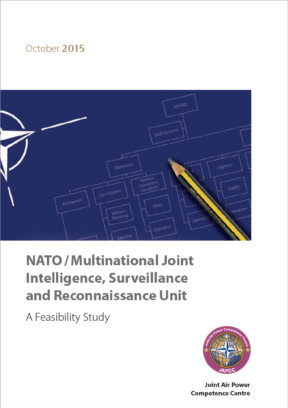Preface
NATO military commanders and Alliance Leaders have consistently identified gaps in NATO’s Intelligence, Surveillance and Reconnaissance (ISR) capability and capacity including the entailed Processing, Exploitation and Dissemination (PED) processes. Exercises such as Unified Vision have begun to address the challenge of passing target information from one ISR system to another for tactical exploitation, targeting and data fusion.
The most recent NATO summit held in Wales on 4 – 5 September 2014 focused on NATO post-Afghanistan against the backdrop of instability in the Ukraine. Amongst other objectives, the Wales Summit Declaration stated that NATO and EU should cooperate closer to ensure that NATO’s Smart Defence and the EU’s Pooling & Sharing initiatives are complementary, that sharing of costs and responsibilities should be better balanced between the United States and the European Nations, and that ISR should be enhanced and reinforced whilst emphasizing multinational cooperation.
In this spirit, this study provides an assessment of the challenges and benefits of creating a Joint ISR Unit, either as a multinational arrangement or as a NATO-procured and owned capability. It determines if the creation of such a unit would be justifiable and feasible, and how it would complement NATO’s existing and planned ISR capabilities such as the NATO Airborne Early Warning or the NATO Alliance Ground Surveillance force to meet the Wales Summit objectives and mitigate NATO’s ISR shortfall. The study concludes with draft structures for both types of ISR units, as well as pre-requisites and recommendations for their design and implementation.
Introduction
As a direct result of experience garnered from campaigns in the Balkans, Afghanistan and most recently in Libya, the Allied Heads of State and Government expressed during NATO’s 2012 Chicago Summit the ambition to strengthen their cooperation in acquiring and maintaining military capabilities to ensure tighter connections between Allied forces. Seeking to ensure NATO has available an enduring Joint Intelligence, Surveillance and Reconnaissance (JISR) capability to achieve strategic and operational decision superiority, Alliance leaders reconfirmed at the 2014 Wales Summit that JISR would remain a high priority for NATO.1,2
Based in the concept of Smart Defence (SD), the Alliance Ground Surveillance (AGS) programme demonstrates the possibilities multinational cooperation provides in capability development and employment.3 In this spirit, this study validates the requirement for and analyses the feasibility of establishing a NATO or Multinational JISR Unit (MNJISRU) equipped with a Medium-Altitude, Long-Endurance (MALE) Unmanned Aircraft System (UAS) (to include remotely operated as well as remotely piloted systems; cf. Chapter 2.3 ff.), providing NATO with additional JISR capabilities at the operational and tactical level to complement the AGS’ strategic level capabilities.
Aim
This study provides an assessment of the challenges and benefits of creating a NATO/MNJISRU. Specifically, it determines if the creation of a NATO/MNJISRU is feasible, how it will complement NATO’s existing ISR capabilities as well as potential near- and longer-term solutions to address NATO’s current Intelligence, Surveillance and Reconnaissance (ISR) capabilities gap. The study analyses and assesses the different options for creating such a unit based on the experiences of already established concepts such as the AGS or the NATO Airborne Early Warning and Control (NAEW&C) force. Finally, the study gives recommendations of a possible future NATO/MNJISRU structure, outlines a concept for integration into the NATO command structure and provides options for suitable UAS and regional basing possibilities.
Assumptions
This study assumes Alliance Member Nations defence budgets will continue to be constrained, resulting in sustained political will to do things more efficiently within NATO and to support the principles of NATO’s Smart Defence (SD) and the European Union’s Pooling & Sharing (P&S) initiatives in the long term. Additionally, this study takes into account the proposed drawdown of U.S. ISR forces in Europe4 as part of the assessment of the future operational environment. Certain types of U.S. manufactured UAS are subject to the U.S. International Trade in Arms Regulations (ITAR), which may impede their participation in a multinational unit. This study assumes that potential challenges with export restrictions for Foreign Military Sales (FMS) could be overcome if NATO as a whole acted as the customer of the respective UAS. This assumption is based on the fact that consensus of all 28 Allies – including the U.S. – would be required for the employment of a NATO-owned UAS unit. Furthermore, the sale of the U.S. Global Hawk to the NATO AGS force could serve as an example for such an FMS case.
Methodology
The study first reviews the significant lessons learned regarding the availability of ISR systems and data in recent NATO campaigns and discusses the impact the resource gap in NATO’s existing ISR capability imposed on decision makers in those campaigns. The study then introduces the principles of SD and P&S as the conceptual foundation of any combined effort to create a NATO/MNJISRU as well as a short summary of statements from the latest NATO summit in Wales which are relevant to these concepts. The study then compares the NATO AGS capabilities currently being integrated into the NATO Force Structure (NFS) with the remaining ISR challenges as identified at the NATO summits in Lisbon (2010), Chicago (2012), and Wales (2014), justifying the creation of a NATO/MNJISRU. Next, considerations for funding such a unit and how to integrate it into the NATO JISR architecture and NATO Command Structure (NCS) are discussed, comparing available UAS platforms and outlining options for manning the unit as well as education and training of dedicated personnel. Finally, the study concludes with recommendations of how a NATO/MNJISRU could be constructed. The study also provides a proposal for both a NATO and a MNJISRU structure, which, when fully manned and funded, would help mitigate NATO’s identified ISR shortfalls.
Limitations
Research and analysis associated with this study include both open and classified sources. To permit the widest dissemination, the published study has been kept at the unclassified level.











